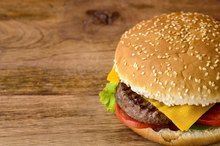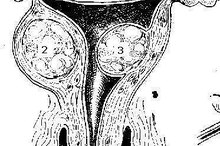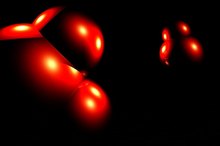How to Shrink Fibroids & Cysts Naturally
Women commonly experience uterine fibroids and cysts, particularly during childbearing years 15. In general, these conditions don't cause discomfort, although for some women, hormonal fluctuations can cause significant pain and bloating. Uterine fibroids, which are noncancerous fibrous growths in the uterus, affect as much as 75 percent of women, according to the Mayo Clinic 125. Ovarian cysts, including polycystic ovary syndrome, are fluid-filled cysts that appear in the ovaries and are fairly common 2. If you are experiencing symptoms related to fibroids or cysts, natural methods can decrease your discomfort. See your doctor before using any natural treatment approach.
Replace simple carbohydrate foods such as white flour products with complex carbohydrates such as fruits, vegetables and whole grains. The Mayo Clinic explains that many women with polycystic ovary syndrome, or PCOS, experience the development of many cysts regularly 2. This syndrome is associated with an increased risk of developing adult onset diabetes. Eating complex carbohydrates adds dietary fiber to your food, which can help slow its digestion and slow the fluctuations in blood sugar that can lead to diabetes. Naturopathy Online adds that women with fibroids are more likely to have poor dietary habits that also can lead to high blood sugar 5.
Can Gout Sufferers Eat Baked Beans?
Learn More
Focus on eating foods that have a low glycemic index value. While high glycemic foods such as corn and potatoes are often thought of as healthy, this may not be the case for women with fibroids or cysts. The Mayo Clinic explains that high glycemic foods cause insulin levels to rise more than foods that have a lower glycemic index value 2. According to the National Uterine Fibroids Foundation, obesity is associated with the development of fibroids 134. In addition, the Mayo Clinic suggests that a diet that is rich in low glycemic foods such as dark leafy greens and beans may help relieve PCOS 2.
Engage in physical activity for at least 30 minutes five days a week. A 2006 study published in the Journal of Epidemiology found that women who exercised experienced less occurrence of uterine fibroid development 3. Additionally, the Mayo Clinic explains that regular exercise can stabilize blood sugar levels, which is of particular importance for women with PCOS 2. Exercise also helps you lose weight and maintain a healthy weight, decreasing the risks associated with obesity and accompanying fibroids and cysts.
Natural Ways to Shrink Fibroids
Learn More
Emphasize healthy protein foods such as fish, beans, legumes and low-fat dairy products instead of red meat or dark meat poultry. The National Uterine Fibroids Foundation explains that one of the risk factors for developing fibroids is the consumption of beef and other red meat 145. Red meat and dark meat poultry also tend to have higher amounts of fats that can lead to weight gain and obesity. Obesity and excess levels of insulin are risk factors for developing fibroids and PCOS, respectively. Decreasing the amount of red meat and dark meat poultry you eat may shrink fibroids and cysts and decrease the likelihood that they will return.
Avoid caffeinated beverages including coffee, tea and soft drinks. According to Dr. William E. Richardson of the Atlanta Clinic of Preventive Medicine, caffeinated beverages contain substances known as methylxanthines 6. These substances can impair the work of enzymes in your body, which can lead to toxic buildup. Toxins can collect in areas around the body, forming cysts or fibroids. The development of uterine fibroids is associated with excess consumption of methylxanthines 15. Instead of flavored beverages, drink at least 64 ounces of water or other caffeine and sugar-free beverages daily.
Tips
Check with your doctor before making significant dietary changes.
Related Articles
References
- Mayo Clinic: Uterine Fibroids
- Mayo Clinic: Ovarian Cysts
- American Journal of Epidemiology: Association of Physical Activity with Development of Uterine Leiomyoma
- National Uterine Fibroids Foundation: Risk Factors
- Naturopathy Online: Uterine Fibroids
- de la Cruz MS, Buchannan EM. Uterine fibroids: Diagnosis and treatment. Am Fam Physician. 2017 Jan 15;95(2):100-107.
- Gurusamy KS, Vaughan J, Fraser IS, Best LM, Richards T. Medical therapies for uterine fibroids - a systematic review and network meta-analysis of randomised controlled trials. PLoS ONE. 2016;11(2):e0149631. doi:10.1371/journal.pone.0149631
- Donnez J, Dolmans MM. Uterine fibroid management: from the present to the future. Hum Reprod Update. 2016;22(6):665–686. doi:10.1093/humupd/dmw023
- National Institute of Child Health and Human Development. Uterine Fibroids.
- The Merck Manuals Online Medical Library. Uterine Fibroids.
- U.S. Department of Health and Human Services. Uterine Fibroids fact sheet.
- Lippman, SA et al. Uterine Fibroids and Gynecologic Pain Symptoms in a Population-Based Study. Fertility and Sterility. 2003 Dec;80(6):1488-94
Resources
Writer Bio
Maura Banar has been a professional writer since 2001 and is a psychotherapist. Her work has appeared in "Imagination, Cognition and Personality" and "Dreaming: The Journal of the International Association for the Study of Dreams." Banar received her Bachelor of Arts in psychology from Buffalo State College and her Master of Arts in mental health counseling from Medaille College.









